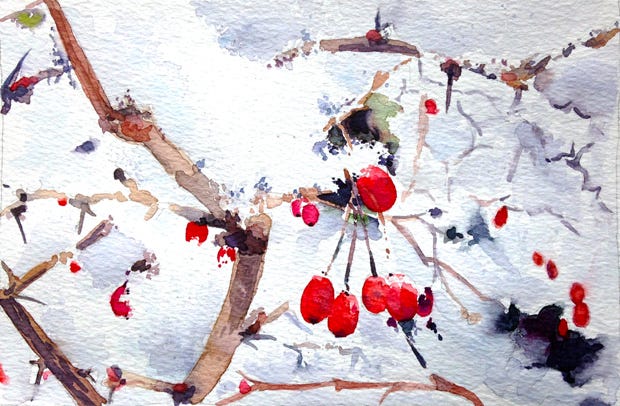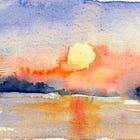Where there is hatred, let me sow love.
The outer is a reflection of the inner, so love begins within. I can sow love by bringing its warmth and compassion into the cold, dark, unloved places deep inside me. This region is moved to tears when touched by a beautiful sunrise or sunset. And by the beauty of the world in general, which is a constant demonstration of love. Red berries dusted with snow, whipped-cream clouds, a young boy singing the high soprano notes opening “Once in Royal David’s City.”
They say the opposite of love isn’t hate, but fear. And doesn’t fear play its role in preventing simple expressions of love when they are most needed? Fear has a self-centered quality; it is a drawing inward, a withholding in response to some imagined and unwanted outcome like pain or shame or loss.
Aggression and aversion are two habitual responses to events and people that disturb us. Both are sourced in a resistance fueled by fear and hate. Fear is the recoil response and hate is the outward manifestation. If love is courage in action, then hate is fear in action. It is beautifully fitting that the word, courage, comes from the Old French word corage, meaning heart.
I’ve long marveled at the bright wisdom of Madeleine L’Engle to give this idea to her character, Proginoskes:
“Love isn't how you feel. It's what you do.”1
Courageous action sourced from love is what I so admire in the scientist and writer,
. In her recent essay, “What if we act as if we love the future?” she shares an excerpt from her climate action book, What If We Get It Right? She details eight practical actions, like keep showing up, join something, find your people, nourish joy, and love nature.“There are innumerable possible futures. I know that we each get some say in which future we’ll collectively have, and a chance to help build it.”2
How do the opposites of love and fear, of action and hiding, show up in my life? Everywhere. When I’m in love with my work, I feel a glowing expansion of my heart, a warm green light of joy, purpose and diligence. Last week reminded me that hate lurks just beneath the surface when fear has me in its grip. Fear crowds into my heart place, creating sharp pain and causing me to lash out in reactive frustration or denial. The word, heartache, is indeed apt.
Cultivating courage within my own darkest places is an ongoing project. John O’Donohue reminds me to be gentle:
“If you keep shining the neon light of analysis and accountability on the tender tissue of your belonging, you make it parched and barren.”3
Nothing looks good under neon. It takes daily dedication to nurturing practices and deep listening inside to counter that harsh light. No wonder I light a candle when I sit in the pre-dawn darkness to write in my journal.
What can I do to cultivate love today? When I feel it, I can show it. For a while now, I’ve had a policy that when I have a kind or complimentary thought about someone—friend, loved one, or stranger—I tell them. Out loud. That I even have this pact with myself should tell you how deep a hole I’ve been in. Maybe I’m not alone: Brené Brown’s TED talks on vulnerability are proof of that.
I love that the word, sow, in this verse implies the dynamic process of an ongoing day-to-day choice to love, in the face of all challenges and temptations to succumb to fear. How generous love is. Love turns outward. Love expands. Love is the conscious act of connection and inclusion. All of that is made possible with self-love, and self-acceptance.
Read the introduction to this series here:
And the first verse, Lord, make me an instrument of thy peace, is considered here.
Each season, we donate 30% of paid subscriptions to a worthy environmental cause. This post helped to raise $92 for the Old Growth Forest Network, the only national network in the U.S. of protected, old-growth, native forests where people of all generations can experience biodiversity and the beauty of nature. Track past and current recipients here.
What did you enjoy most about this essay? I’d love to hear from you. Or share it with others by restacking on Notes, via the Substack app. Thanks!
In her story, The Wind in the Door, Proginoskes is a wise, ancient being who mentors the main character, Meg Murry.
From Anam Cara







You're inspiring me to think closely about each line along with you. Here I'm caught by the metaphor "sow." We never sow and harvest in the same season. There is reason to let ourselves feel peace even when we're surrounded by "hatred" if we believe we've done what we can to "sow" love. I'd not given thought to that little word before. It seems like a reminder to that we won't see results in this world of struggle right away. That doesn't mean we're doing it wrong. Your watercolor seems to clinch it. What could be more peaceful than berries in the snow?
Julie, with your 1st post about St. Francis' prayer, and now even more with this one, I was reminded of an invocation that I read years ago in a book about runes, that ends "I am the sower and the sown, God's self unfolding, and God's own." Thank you for your writing and consideration of the ways to turn hate to love.